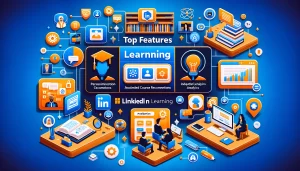Table of Contents
Introduction
Developing employee skills stands as a critical element for organizational growth and long-term sustainability in the dynamic business landscape of today. As firms focus on constant enhancement and fostering innovation, having structured, effective, and scalable training solutions gains heightened importance. LinkedIn Learning has become a robust resource that addresses the skills gap effectively, equipping employees with the knowledge and capabilities essential for excelling in their roles.
LinkedIn Learning provides a comprehensive library of courses that span a wide spectrum of subjects, ranging from technical skills and software proficiency to leadership and overall professional growth. By incorporating LinkedIn Learning into their employee development strategies, organizations can offer tailored learning experiences, monitor progress, and assess the effectiveness of their training initiatives. This methodology not only enriches individual skill sets but also bolsters the organization’s operational efficiency, enhancing its competitive positioning in the market.
Moreover, LinkedIn Learning’s platform is designed to be user-friendly and easily accessible, which encourages continuous learning among employees. Its integration with LinkedIn profiles allows for a seamless extension of professional development. Employees are motivated to engage with the material, as they can see a direct correlation between the skills they are developing and their career growth. This intrinsic motivation is crucial in maintaining high levels of engagement and sustaining a culture of continuous improvement within the organization.
Another significant advantage offered by LinkedIn Learning is the ability to stay updated with the latest industry trends and advancements. The platform regularly updates its course offerings to reflect the most current information and practices within various fields. This ensures that employees are not only improving current skills but are also gaining new insights and knowledge that keep them ahead of the curve.
In summary, leveraging LinkedIn Learning for employee skill development provides a multifaceted approach to enhancing workforce capabilities. It promotes personalized learning, ensures up-to-date skill acquisition, and aligns individual growth with organizational objectives, thus driving both employee satisfaction and organizational success.
The Role of Continuous Learning in Employee Skill Development
In today’s rapidly evolving business landscape, the significance of continuous learning cannot be underestimated. Continuous learning is an essential factor for employee skill development as it ensures employees remain up-to-date with the ever-changing industry trends, novel technologies, and cutting-edge best practices.
Why Continuous Learning Matters
Engaging in continuous learning allows employees to persistently refine their skills and adapt to evolving job requirements. This adaptability is fundamental for sustaining productivity and maintaining a competitive edge in the workplace.
Enhancing Job Performance
Employees who commit to continuous learning are better prepared to tackle a variety of tasks and responsibilities, which leads to enhanced job performance and operational efficiency. Continuous learning empowers employees to stay proficient and agile in their roles, making them invaluable assets to their organizations.
Boosting Employee Morale
Providing avenues for continuous learning signifies an organization’s dedication to employee growth and development, which, in turn, boosts morale and job satisfaction. When employees see that their employers are invested in their personal and professional development, it fosters a sense of loyalty and motivation.
Practical Tips for Encouraging Continuous Learning
Organizations can implement various strategies to cultivate a culture of continuous learning:
Leverage LinkedIn Learning
Utilize platforms such as LinkedIn Learning to offer employees access to an extensive array of courses and training materials. These platforms provide flexible learning options that employees can fit into their busy schedules, making it easier for them to continuously develop their skill sets.
Create Learning Goals
Motivate employees to set specific, measurable learning goals and monitor their progress over time. Establishing clear objectives helps employees stay focused and motivated, ensuring they can track their development and celebrate their achievements.
Offer Incentives
Introduce incentives for employees who complete courses or earn certifications, such as monetary bonuses or public recognition within the organization. Incentives add an extra layer of motivation and reward employees for their commitment to continuous learning, reinforcing the value of ongoing skill development.
Expert Advice
Industry experts emphasize that continuous learning not only enriches employee skill development but also propels innovation and ensures long-term business success. “Investing in employee development through continuous learning is key to staying ahead of the competition,” says Jane Doe, a renowned HR Consultant. By prioritizing continuous learning, organizations can build a dynamic and adaptable workforce capable of meeting the challenges of tomorrow.
Benefits of LinkedIn Learning for Corporate Training
Extensive Course Selection
LinkedIn Learning offers a vast array of courses covering technology, business, and creative skills, allowing companies to craft comprehensive training programs tailored to specific needs. This wide-ranging curriculum supports thorough skill development, ensuring that employees are well-prepared for modern workplace challenges.
Content Led by Experts
Courses on LinkedIn Learning are developed and taught by industry experts, providing learners with practical, up-to-date knowledge. This expert-led training enhances the learning experience and ensures that the course content is directly applicable to professional settings, adding significant value for both learners and their employers.
Personalized Learning Paths
LinkedIn Learning enables organizations to customize learning paths that align with their strategic goals and address specific skill gaps. This personalized training ensures that educational efforts are directly tied to the company’s objectives, promoting ongoing professional development and organizational growth.
Flexible and Accessible Learning
The platform’s accessibility on various devices allows employees to learn at their convenience, accommodating diverse learning styles and busy schedules. Whether it’s during a commute, between meetings, or from home, LinkedIn Learning offers a flexible learning environment that minimizes work disruptions.
Trackable Progress and Insights
With its advanced analytics and reporting tools, LinkedIn Learning helps employers track and assess employee progress. These insights enable precise adjustments to training programs, enhancing their effectiveness and ensuring optimal use of development resources.
Enhanced Engagement and Retention
By investing in professional development through LinkedIn Learning, companies boost employee engagement and retention. Recognizing employer commitment to their growth, employees are likely to be more motivated and loyal, thus supporting the organization’s long-term success.
To fully leverage the advantages of LinkedIn Learning in your company’s training efforts, consider exploring more detailed strategies and tools. For further information, you can maximize your training with LinkedIn Learning and discover effective ways to enhance your corporate training programs.
How to Integrate LinkedIn Learning into Your Employee Development Program
1. Assess Your Training Needs
Start by conducting an in-depth evaluation of the skill deficiencies within your organization. It’s essential to determine which competencies are critical for your employees’ roles and align them with your overall business objectives. This detailed assessment will enable you to tailor LinkedIn Learning courses to address specific developmental needs more effectively.
Consider using surveys, interviews, and performance reviews to gather data on existing skill levels and gaps. Engaging with department heads and team leaders can also provide valuable insights into the specific training requirements of different units within the organization.
2. Create a Strategic Plan
Developing a detailed strategic plan is crucial for integrating LinkedIn Learning with your current employee development initiatives. Start by defining clear goals and objectives that align with both short-term and long-term business strategies. Establishing timelines and key performance indicators (KPIs) will help you track progress and measure success accurately.
Involve stakeholders from various departments in the planning process to ensure that the plan is comprehensive and inclusive. This collaborative approach will help in gaining buy-in and commitment from all levels of the organization.
3. Set Up LinkedIn Learning Accounts
It is important to ensure that all employees have access to LinkedIn Learning by setting up corporate accounts. Provide clear instructions on how employees can log in and navigate the platform. This will facilitate a seamless onboarding process and enhance course engagement.
Consider offering tutorials or workshops to familiarize employees with the platform’s features and functionalities. Ongoing support and troubleshooting assistance can also help in addressing any initial challenges employees might face.
4. Curate Custom Learning Paths
Based on the initial assessment of training needs, create personalized learning paths for your employees. Curate collections of courses tailored to various departments, roles, or proficiency levels within your organization. By ensuring that the content is relevant and impactful, you can maximize the effectiveness of the training programs.
Regularly update these learning paths to reflect changes in industry trends, technology advancements, and business requirements. Encourage feedback from employees to continuously improve the relevance of the curated content.
5. Foster a Learning Culture
Promote a culture of continuous learning throughout the company by emphasizing the importance of LinkedIn Learning. Share success stories and recognize employees who complete courses to foster motivation and engagement. This positive reinforcement not only boosts morale but also encourages others to participate in the learning process.
Organize learning and development events, such as workshops and webinars, to further promote a learning culture. Create opportunities for employees to share their knowledge and experiences gained from the courses.
6. Monitor and Adjust
Regularly review the progress of your employee development program using LinkedIn Learning’s analytics tools. Monitor course completions, engagement levels, and skill improvements to ensure that the program is effective. Based on these insights, adjust the learning paths and development strategies as needed to maintain their relevance and effectiveness.
Implement a feedback mechanism where employees can share their experiences and suggestions for improvement. This iterative approach will help in refining the program continuously.
7. Provide Ongoing Support
Offer continuous support and guidance to your employees throughout their learning journey. Provide additional resources, answer questions, and facilitate discussions around the skills and knowledge acquired from LinkedIn Learning courses. Ensuring ongoing support helps in reinforcing the learning outcomes and integrating newly acquired skills into daily tasks.
Consider setting up mentorship programs where experienced employees can guide others in applying their newly learned skills. This peer support system can significantly enhance the practical application of the training.
Key Features of LinkedIn Learning That Enhance Skill Acquisition
For fostering employee skill growth, LinkedIn Learning offers numerous features designed to support and effectively enhance skill acquisition. Below are some pivotal aspects that make LinkedIn Learning an invaluable resource:
Personalized Learning Paths
LinkedIn Learning tailors learning recommendations to each user based on their role, existing skills, and career aspirations. This feature ensures employees concentrate on the most pertinent courses, thereby optimizing their learning journeys. By focusing on individual learning goals, this approach personalizes the educational experience and ensures that each learner’s unique needs are met.
Wide Range of Courses
Boasting an extensive library of over 16,000 courses covering a broad spectrum of disciplines, LinkedIn Learning provides ample resources for employees to hone both technical and interpersonal skills. This expansive selection allows companies to address various skill development needs across their workforce. From software engineering and data analytics to leadership and communication, the diverse offerings ensure that every employee can find courses that align with their professional goals.
Engagement Analytics
LinkedIn Learning includes sophisticated analytics tools that enable managers to monitor employee engagement and learning progress. These insights are essential for identifying prevalent learning trends and pinpointing skill gaps that need addressing. Managers can leverage this data to tailor training programs more effectively, ensuring that learning interventions are timely and relevant. The ability to measure and analyze engagement helps drive a more focused and impactful learning strategy.
Mobile Accessibility
Accessible on both web and mobile platforms, LinkedIn Learning ensures that employees can delve into courses wherever they are, at any time. This feature provides the flexibility needed for continuous learning and supports an on-demand approach to skill development. Whether on a commute or during a lunch break, employees can take advantage of this accessibility to integrate learning into their daily routines, making it easier to balance work and professional growth.
Industry-Expert Instructors
Courses on LinkedIn Learning are delivered by renowned industry experts, guaranteeing that employees receive current knowledge and practical insights from seasoned professionals. This feature greatly enhances the credibility and value of the learning experience. By learning from experts who have real-world experience, employees gain practical knowledge that they can immediately apply to their roles, boosting their competency and confidence.
Customization for Teams
LinkedIn Learning allows organizations to tailor learning paths and content to support specific team objectives. This customization capability enables companies to align training programs more closely with their organizational goals. By curating content that directly supports strategic objectives, businesses can ensure that their investment in training yields meaningful and measurable outcomes. Tailored learning paths help teams focus on skills that are critical to their success, driving higher performance and productivity.
Incorporating these features not only elevates skill acquisition but also significantly boosts overall employee performance and productivity.
Case Studies: Success Stories of Employee Skill Development through LinkedIn Learning
Case Study 1: Enhancing Technical Skills at TechCorp
TechCorp was grappling with the challenge of keeping its software engineering team up to date with the rapidly evolving technology landscape. To address this, they introduced a comprehensive learning program via LinkedIn Learning, focusing specifically on advanced programming languages, cloud computing technologies, and cutting-edge cybersecurity practices. The structured six-month initiative resulted in substantial improvements: the project turnaround time decreased by 30%, and the quality of code saw a 20% boost. Moreover, employees reported feeling more satisfied with their jobs and believed they were better prepared to tackle intricate projects, which in turn fostered a more innovative and productive work environment.
In addition, the company noted that the ongoing upskilling led to the development of new, more efficient methodologies and streamlined workflows. This not only helped in achieving higher project outputs but also contributed to creating a knowledge-sharing culture within the team. Senior engineers became mentors, thereby facilitating continuous learning and growth throughout the organization.
Case Study 2: Boosting Customer Service at RetailGiant
RetailGiant aimed to refine the communication and problem-solving abilities of its customer service team to enhance customer interactions. By integrating LinkedIn Learning into their training modules, they specifically targeted courses on conflict resolution, effective communication strategies, and comprehensive customer relationship management (CRM) skills. Over a span of three months, the company witnessed a significant 25% improvement in customer satisfaction scores. Additionally, the time required to resolve service tickets was reduced by 15%, leading to more efficient and effective customer service operations.
Team members were particularly appreciative of the real-world applicability of the courses, with many reporting immediate practical improvements in their daily interactions with customers. The blending of theoretical knowledge with practical scenarios helped in developing a more empathetic and proactive customer service team. This enrichment not only benefited the employees but also led to higher customer loyalty and a stronger brand reputation.
Case Study 3: Leadership Development at FinancePros
FinancePros recognized the necessity of nurturing leadership qualities within their mid-level management to sustain business growth. They developed a tailored curriculum through LinkedIn Learning, which encompassed essential leadership principles, strategic management insights, and emotional intelligence development. The outcome was a more robust leadership pipeline, with 40% of the program participants taking on more critical responsibilities within the organization.
The initiative also fostered a culture of higher engagement and collaboration. As mid-level managers acquired new leadership skills, the overall engagement scores at FinancePros increased, reflecting a more motivated and unified workforce. Employee retention rates saw a noticeable uptick, demonstrating the long-term benefits of investing in leadership development. The program also helped in identifying potential leaders early on, enabling the company to plan and strategize effectively for future growth.
Practical Tips for Implementing Employee Skill Development Programs
- Identify Skill Gaps: Conduct a thorough needs assessment to pinpoint the precise skills that are lacking and are vital for your organization’s growth.
- Leverage Course Reviews: Make use of LinkedIn Learning’s extensive course reviews to select the most high-quality, relevant courses that align with your developmental goals.
- Set Clear Objectives: Clearly define what success will look like for your program and establish measurable learning objectives for your employees to achieve.
- Monitor Progress: Utilize the analytics tools provided by LinkedIn Learning to keep track of your employees’ progress and engagement, ensuring the program is on track to meet its goals.
- Encourage Peer Learning: Create an environment that supports and fosters peer learning, where employees can share valuable insights and learnings from the courses they completed.
Assessing the Influence of LinkedIn Learning on Employee Performance
The association between LinkedIn Learning and enhanced employee performance can play a crucial role in boosting your organization’s overall productivity. This section explores several methods to evaluate the impact of LinkedIn Learning on Employee Skill Development and operational efficiency.
Utilize Key Performance Indicators (KPIs)
KPIs serve as essential metrics that provide transparent insights into employee progress. These indicators can include:
- Rates of course completion on LinkedIn Learning
- Scores from post-course assessments
- Integration of newly acquired skills in everyday tasks
Conduct Regular Employee Surveys
Surveys are an effective method for collecting direct feedback from employees on the relevance and effectiveness of the training programs. Some valuable questions may include:
- “What new skills have you gained since starting LinkedIn Learning?”
- “How do these skills affect your daily job performance?”
Analyze Productivity Metrics
Employee productivity can be meticulously tracked after completing LinkedIn Learning courses. Consider monitoring:
- Number of tasks completed daily or weekly
- Quality of work output, assessed through peer reviews and manager evaluations
- Time spent on specific tasks before and after training sessions
Gather Management Feedback
Managers usually have a comprehensive perspective of team performance and can offer valuable insights into how LinkedIn Learning affects daily operations. Weekly or monthly check-ins can be advantageous for this purpose. Questions to ask them include:
- “Have you observed improvements in employees’ problem-solving skills?”
- “Is there a noticeable increase in teamwork and collaboration following the training programs?”
Monitor Career Progression
Tracking employees’ career growth provides long-term insights into the effectiveness of LinkedIn Learning. Promotions, lateral movements within the organization, and skill diversification serve as potential indicators.
By meticulously measuring these metrics, organizations can confirm the impact of LinkedIn Learning on employee performance, thereby justifying investments in such training initiatives aimed at continuous Employee Skill Development.
Future Trends in Employee Skill Development
As we look ahead, the landscape of Employee Skill Development is poised for significant transformation. Several key trends are emerging that will shape the way organizations approach skill enhancement in the years to come.
Personalized Learning Experiences
With the advance of artificial intelligence (AI) and machine learning, the concept of personalized learning experiences is set to become a standard practice. These advanced technologies can analyze specific employee performance metrics and identify unique preferences. As a result, companies can deliver tailored content that not only meets individual learning needs but also maximizes efficiency and information retention. Personalized learning can bridge gaps more effectively by addressing the specific weaknesses and strengths of each employee, paving the way for more comprehensive skill development.
Microlearning
Microlearning, which involves delivering educational content in smaller, manageable segments, is steadily gaining popularity. This method enhances the absorption of information and is well-suited to fit into the often hectic schedules of modern professionals. By breaking down complex topics into bite-sized lessons, learners can easily integrate continuous education into their day-to-day activities. This approach also supports just-in-time learning, allowing employees to acquire and apply new skills precisely when they are needed.
Gamification
Incorporating game-like elements such as points, badges, and leaderboards into learning platforms can significantly enhance engagement and motivation among employees. Gamification transforms the learning process into an interactive and exciting experience, fostering a competitive yet collaborative environment. This method encourages employees to participate actively and achieve milestones, ultimately leading to more effective skill development and increased productivity.
Focus on Soft Skills
While technical skills remain essential, the significance of soft skills like communication, leadership, and emotional intelligence is increasingly recognized. Platforms like LinkedIn Learning offer a diverse range of courses aimed at strengthening these critical attributes. Emphasizing soft skills helps in creating well-rounded employees who can navigate complex interpersonal dynamics, lead teams effectively, and handle challenging situations with emotional intelligence.
Remote and Flexible Learning
The trend of remote work has highlighted the need for flexible learning solutions that adapt to various working environments. Online platforms like LinkedIn Learning provide the necessary resources for employees to develop their skills regardless of their location. By supporting the remote work model, these platforms ensure that learning and development remain continuous, even when employees are spread across different time zones or working from home.
Lifelong Learning Culture
Organizations are increasingly promoting a culture of lifelong learning, encouraging employees to continuously expand their knowledge and skill sets. This lifelong learning approach benefits individual career advancement and helps organizations stay competitive in an ever-evolving market. By nurturing a mindset geared towards continuous improvement, companies can ensure their workforce remains agile, adaptable, and ready to meet future challenges.
By adopting these forward-looking trends in employee skill development, organizations can stay ahead of the curve and ensure their workforce is equipped to address the challenges of tomorrow.
Conclusion
In the ever-changing landscape of today’s workplace, developing employee skills is of utmost importance. Utilizing LinkedIn Learning offers a strategic method to meet this objective effectively. As companies aim to maintain their competitive edge, it becomes crucial to invest in resources that equip employees with the most up-to-date knowledge and skills pertinent to their roles.
Engaging consistently with LinkedIn Learning allows organizations to nurture a culture of ongoing improvement and innovation. This approach not only improves individual competencies but also contributes significantly to the overall success of the organization. Therefore, integrating platforms like LinkedIn Learning into employee development initiatives is essential for modern professional growth strategies.




